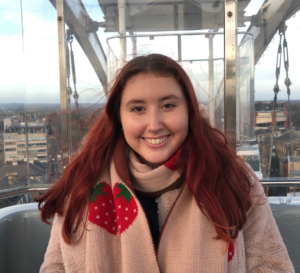Developing Changing Relations’ Approach To Disability Inclusion
We were lucky enough, once again, to be granted a fabulous Durham University intern via the Careers’ Service Social Enterprise Live Programme. Here, Millie Stott blogs about her experience of developing a new disability inclusion policy for Changing Relations.
I am in my final year of my BA English Literature degree at Durham University, and this summer participated in an internship with Changing Relations, researching stories of disability inclusion. The Changing Relations steering group had identified the need for a disability inclusion policy, which I have worked on developing and presenting in a creative way. The internship has helped me to develop my skills of interviewing, creatively presenting data and managing my time effectively, which I hope to take into a career in the charity sector after I graduate.
Living as a chronically ill young person, it can be easy to feel isolated, detached from those around you who seem to be living their lives free of the difficulties of fatigue and everyday pain. Even though I have lived with pain every day since my late teens, I still struggled to identify myself as disabled, not knowing if this applied to me or my experiences. For this reason, when I was hired as a summer intern with Changing Relations to collect stories of disability and present these in a creative way, I decided to focus my project on narratives of invisible disability, collecting stories from people whose conditions, like mine, could not be seen from the outside, but were still valid and had an impact on everyday life for a multitude of reasons.
Throughout the project, I interviewed nine people from very different careers and backgrounds, students, poets, artists, business owners and academics. One of my personal goals from the project was to work on my interviewing skills, something I did not previously have much experience with. As a student, having the opportunity to interact with professionals, and build my confidence in having discussions in a workplace context, was invaluable. I developed these skills whilst talking to some incredibly interesting people and hearing their stories about their experiences in the workplace and engaging with cultural activities, learning about the multifaceted experience of disability along the way. It was particularly enlightening to explore gender differences in relation to situations of medical gaslighting, being treated fairly in the workplace, and the connection between physical appearance and invisible disability.
At the beginning of the project, myself and Lisa decided it would be helpful to hear the perspectives of professionals working in cultural organisations to learn about what had worked for their company in regards to disability projects and inclusivity. I spoke to professionals from Stockton Arc, Daisy Chain and the North East Inclusive Dance Network. It was interesting to hear their views on specific policies and ideas which would help to even out inequalities in the workplace and in creative fields.
From all of the interviews I conducted over the summer, I began to compile recurring themes and ideas which stood out as important; issues of stereotyping, the language of disability, the recruitment process and the need for online spaces were particularly prevalent in most of the interviews. Hope Simpson, a member of the Changing Relations steering group, was involved in my recruitment, and early conversations with her sparked the idea of accompanying the stories I collect with her visuals. As an artist and photographer, Hope began to analyse these themes visually, creating illustrations and photographs which represented the words of individual interviewees. Her work, drawing from her own experiences of invisible disabilities and the motifs of the interviews, brings out some of the differing aspects and challenges of those we interviewed.
Using Hope’s artwork and the themes I compiled, I came up with a document intended for workplaces and cultural organisations to use in order to better their understanding of invisible disability. Each heading features two quotes pulled from the interviews, allowing different viewpoints and voices to come through. The importance of adaptation and opening up about health and disability is highlighted throughout. The narratives also emphasise that everyone identifies with their label of disability very differently, and none of these ways is wrong.
Hearing and exploring this throughout the project, I have reflected on my own identity and become more comfortable talking about disability theory outside of my individual experiences. This has been invaluable to my English Literature dissertation, which analyses the importance of women’s illness narratives in contemporary society. Going forward with the project, we are hoping to explore the possibility of an event or workshop to share Hope’s artwork and our findings, and hopefully help to further share the diversity of the disabled experience in 2023. We are considering the idea of creative workshops around the content of the stories and artwork collected, and this will be a chance for me to work alongside more experienced facilitators and build my confidence in this area.
We are absolutely delighted with the beautiful art Hope has produced to bring Millie’s important policy document to life. Thank you so much for all of your hard work Millie. We look forward to working with you as we explore ways we can share the perspectives on disability inclusion you have brought to bear through your thoughtful interviews and insightful analysis.




